Module 1 unit 1 Did you come back yesterday 课件 30张
文档属性
| 名称 | Module 1 unit 1 Did you come back yesterday 课件 30张 |  | |
| 格式 | zip | ||
| 文件大小 | 1.9MB | ||
| 资源类型 | 教案 | ||
| 版本资源 | 外研版(三年级起点) | ||
| 科目 | 英语 | ||
| 更新时间 | 2018-09-29 11:06:03 | ||
图片预览



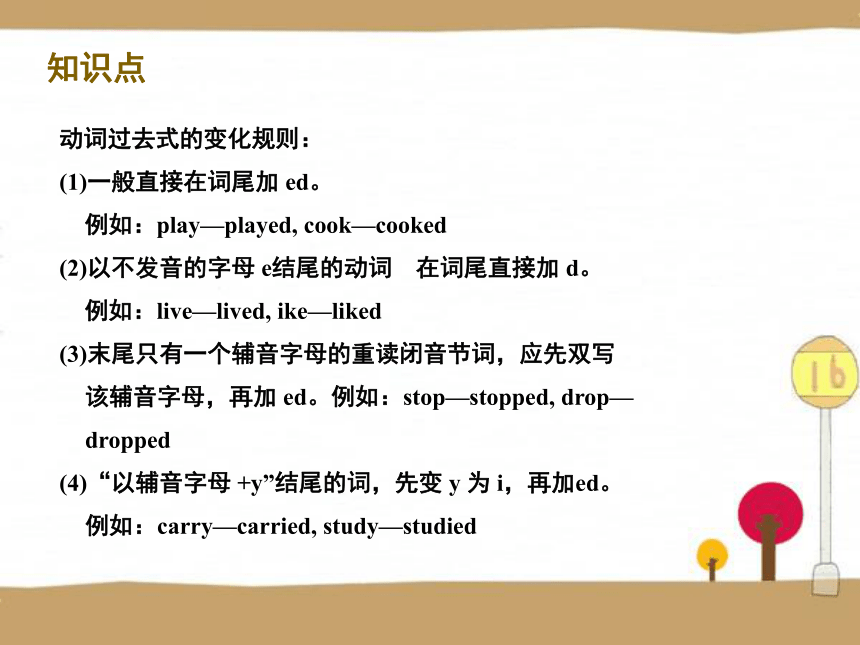

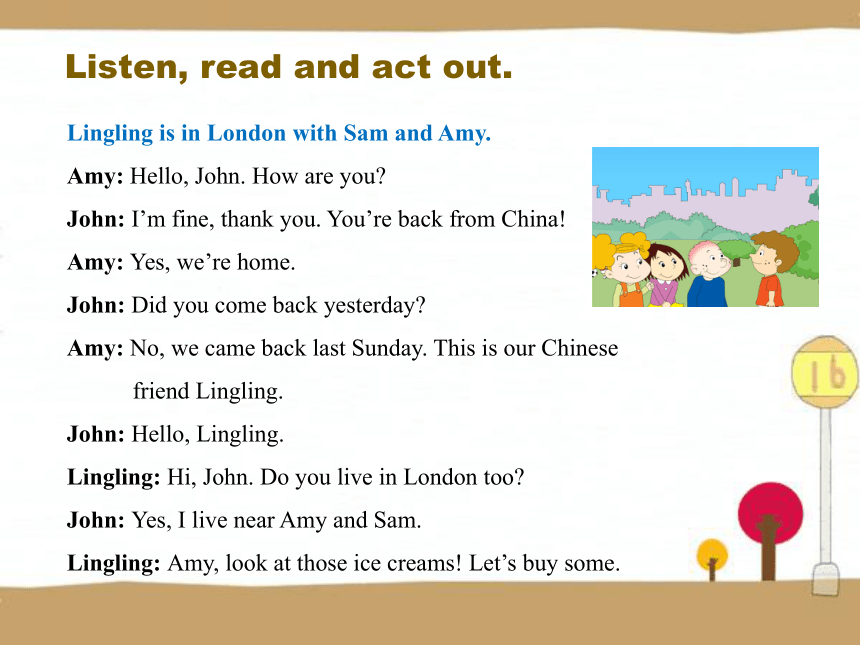
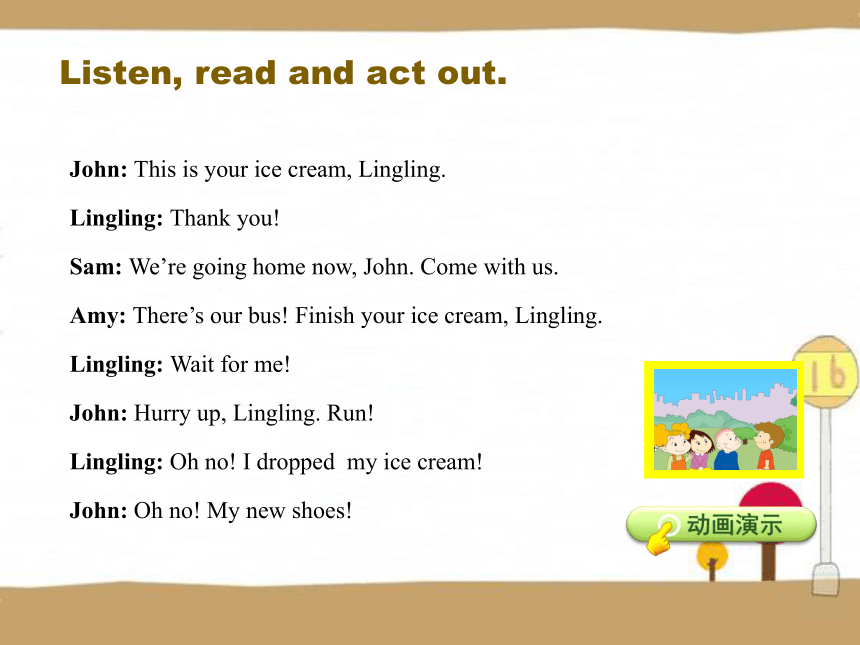


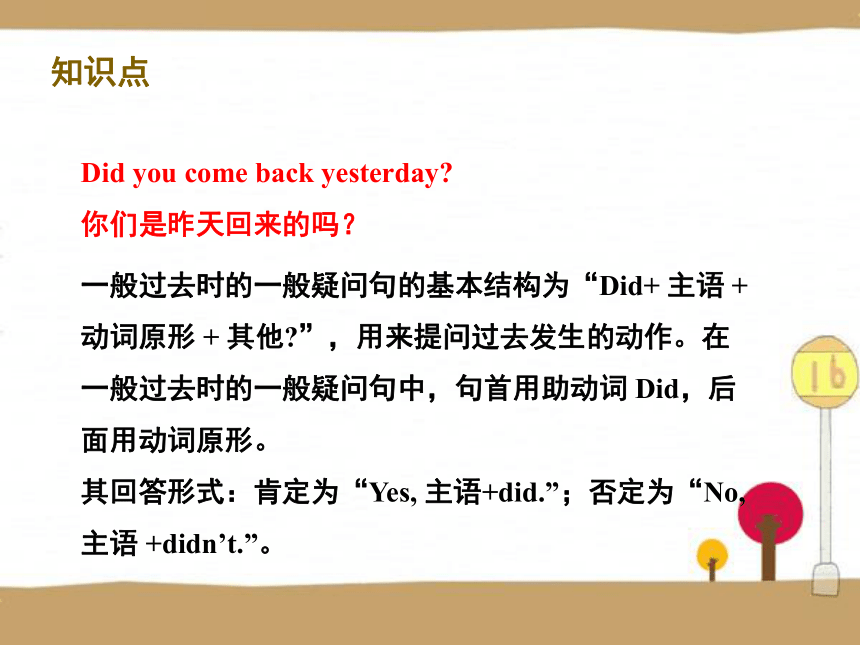
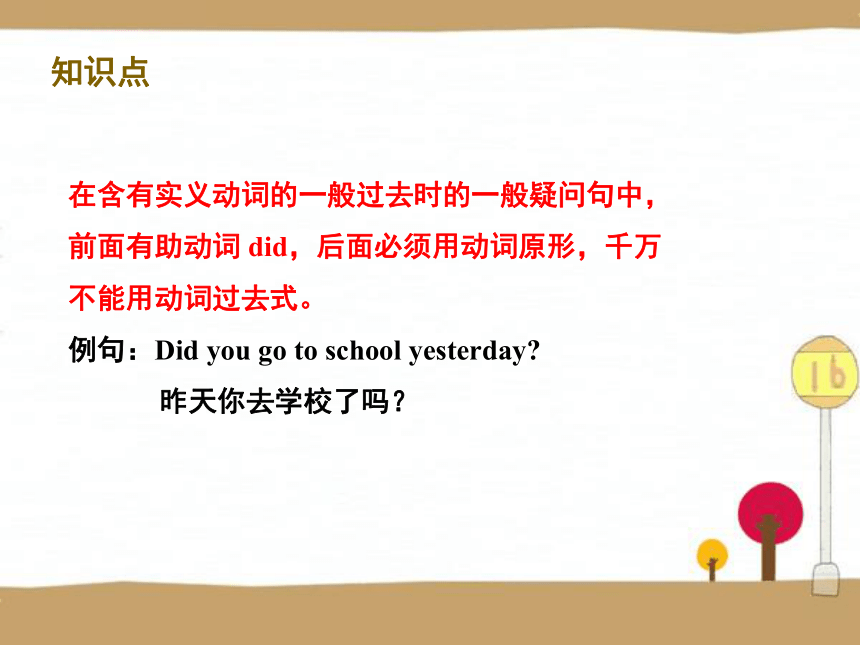

文档简介
课件30张PPT。Unit 1 Did you come back yesterday?
Module 1Listen and chant. met /met/ v.(meet 的过去式)遇见,碰上He met his friends in the park.
他在公园里遇到了他的朋友们。let(vt.)让例句:形近词:字母 e 在单词中发 /e/,类似发音的单词有
next,fell。发音:知识点动词过去式的变化规则:
(1)一般直接在词尾加 ed。
例如:play—played, cook—cooked
(2)以不发音的字母 e结尾的动词?在词尾直接加 d。
例如:live—lived, ike—liked
(3)末尾只有一个辅音字母的重读闭音节词,应先双写该辅音字母,再加 ed。例如:stop—stopped, drop—dropped
(4)“以辅音字母 +y”结尾的词,先变 y 为 i,再加ed。例如:carry—carried, study—studied知识点动词过去式
“一改、二多、三少、四刚刚好”。一改,以“y” 结尾 , 把“y”“去掉改为“I””再加“ ed”,如:study → studied;二多,重读闭音节,双写末尾辅音字母再加“ ed”“,如:stop → stopped;三少,以不发音字母“ e””结尾的动词,可直接加上“ d”, 如:live → lived;四刚刚好 , 就是直接加上“ed”,如:work → worked。知识点Listen, read and act out.Lingling is in London with Sam and Amy.
Amy: Hello, John. How are you?
John: I’m fine, thank you. You’re back from China!
Amy: Yes, we’re home.
John: Did you come back yesterday?
Amy: No, we came back last Sunday. This is our Chinese
friend Lingling.
John: Hello, Lingling.
Lingling: Hi, John. Do you live in London too?
John: Yes, I live near Amy and Sam.
Lingling: Amy, look at those ice creams! Let’s buy some.Listen, read and act out.John: This is your ice cream, Lingling.
Lingling: Thank you!
Sam: We’re going home now, John. Come with us.
Amy: There’s our bus! Finish your ice cream, Lingling.
Lingling: Wait for me!
John: Hurry up, Lingling. Run!
Lingling: Oh no! I dropped my ice cream!
John: Oh no! My new shoes! be back from...?从……返回这里 be 动词不仅随人称代词的变化而变化,
还要随句子的时态进行相应的变化(如一般过去时用was 或 were),from 后跟的是表示地方或国家的词。用法:例句:You’ re back from China!
你们从中国回来了!知识点She ??? back from Beijing yesterday.
A. is??B. was??C. are??D. wereBWe came back last week.
我们是上周回来的。辨析:例句:be back强调结果??come back 强调动作知识点Did you come back yesterday?
你们是昨天回来的吗?一般过去时的一般疑问句的基本结构为“Did+ 主语 +
动词原形 + 其他?”,用来提问过去发生的动作。在
一般过去时的一般疑问句中,句首用助动词 Did,后
面用动词原形。
其回答形式:肯定为“Yes, 主语+did.”;否定为“No,
主语 +didn’t.”。知识点在含有实义动词的一般过去时的一般疑问句中,
前面有助动词 did,后面必须用动词原形,千万不能用动词过去式。
例句:Did you go to school yesterday?
昨天你去学校了吗?知识点...We came back last Sunday.?
……我们是上周日回来的。例句:last Sunday 上周日I went there last Sunday.
我上周日去了那里。由last和时间名词构成的短语有:last year去年,last month 上个月,last week 上周,last?Sunday/Monday上星期天 / 星期一知识点句中有由“last + 时间名词”构成的时间
状语时,句子要用一般过去时。We ??? football last Sunday.
A. played???B. play???C. playsA知识点句式用法:一般过去时态的肯定句此句是典型的一般过去时态的肯定句,?基本结构是“主语+ 动词过去式 + 其他”,其否定句式是“主语 +didn’t+ 动词原形 + 其他”,表示在过去某个时间里发生的动作或存在的状态。常和表示过去的时间状语连用,常见的过去时间状语有:yesterday/last?Sunday/last?night/last?year/last?week等。知识点Do you live in London too?
你也住在伦敦吗?此句是由 do 引导的一般现在时的含有实义动词的一般疑问句,其句型结构是“Do/Does+ 主语 + 动词原形 + 其他?” 表示对事情、状态、特征、喜好等的提问,其肯定回答为“Yes, 主语 +do/does.”“否定回答为“No, 主语 +don’t/doesn’t.”。知识点当用 does 提问时,后面的动词要用动词原形,不能用动词的第三人称单数形式。Tom does homework every day.
(改为一般疑问句)
________________________________ Does Tom do homework every day?知识点those /e??z/ pron. & adj. 那些例句:Look at those people. 看看那些人。that 那个助记:把意义相对应的单词归纳在一起记忆单词的方法就是对应词记忆法。
如:those(那些)—?these(这些)those 的单数形式:知识点us /?s/ pron.(宾格)我们例句:Come with us. 跟我们一起走吧。all of us 我们全部助记:就是一个单词是在另一个单词的基础上减去一部分字母组成的。利用减法记忆法能让同学们更好、更快地记住单词,熟练掌握单词的音、义、形。如:bus(公共汽车)-b=us(我们)短语:us(宾格)—we(主格)词形变化:知识点finish /f?n??/ v. 吃完,喝完,用尽例句:Finish your ice cream, Lingling.
玲玲,吃完你的冰激凌。finish(完成)其他意义:过去式 finished?
现在分词 finishing词形变化:知识点词语辨析:知识点for后面直接跟宾语,构成wait for sb. /sth.等待某人 / 某物。若接人称代词时需用宾格。wait for 等待例句:He is waiting for you outside the house.
他正在房屋外面等你。知识点hurry up 快点Hurry up! We’re late!
快点!我们迟到了!
hurry是“匆忙”的意思,与up连用,主要用于催促别人“快点”。也可以用“Please hurry.”。短语:in a hurry 迅速,赶快例句:用法:知识点dropped /dr?pt/ v.(drop 的过去式)
(无意中)使掉落I dropped my ice cream.
我的冰激凌掉了。drop 是末尾只有一个辅音字母的重读闭音节词,其过去式要双写最后一个辅音字母 p 再加 -ed,即 dropped,类似变化的词还有 stop — stopped。例句:知识点 Listen and say.John: Did you come back yesterday?
Amy: No, we came back last Sunday.Lingling: Oh no! I dropped my ice cream!Practise. 本节课我们学习了以下知识,请同学们一定加强巩固,以便能和同学们进行灵活交流哦!重点词汇:met, those, us, finish
重点短语:be back from, waiting for, hurry up
重点句式:Did you come back yesterday?Summary一、单项选择。
1. He his teacher last week.
A. visits B. visited C. visiting
2. How you, Bill?
A. is B. are C. am
3. —Did Lingling go to the park yesterday?
— _______________________
A. Yes, she did. B. No, she did. C. Yes, I did.BBA Homework4. —Do you __________?
—Yes, I do.
A. play the piano B. played the piano
C. plays the pianoB在含有实义动词的一般现在时的一般疑问句中,前面有助动词Do,后面必须用动词原形。 Homework二、用所给词的适当形式填空。
1. We (come) back last month.
2. Let’s (take) some photos.
3. Let (we) go to the zoo.
4. He (stop) smoking a long time ago.cametakeus此句的句式为“Let’s+动词原形+其他”,意思为“让我们……吧。”是一种提建议的方式。Let 后面用人称代词宾格。stopped HomeworkThanks!
Module 1Listen and chant. met /met/ v.(meet 的过去式)遇见,碰上He met his friends in the park.
他在公园里遇到了他的朋友们。let(vt.)让例句:形近词:字母 e 在单词中发 /e/,类似发音的单词有
next,fell。发音:知识点动词过去式的变化规则:
(1)一般直接在词尾加 ed。
例如:play—played, cook—cooked
(2)以不发音的字母 e结尾的动词?在词尾直接加 d。
例如:live—lived, ike—liked
(3)末尾只有一个辅音字母的重读闭音节词,应先双写该辅音字母,再加 ed。例如:stop—stopped, drop—dropped
(4)“以辅音字母 +y”结尾的词,先变 y 为 i,再加ed。例如:carry—carried, study—studied知识点动词过去式
“一改、二多、三少、四刚刚好”。一改,以“y” 结尾 , 把“y”“去掉改为“I””再加“ ed”,如:study → studied;二多,重读闭音节,双写末尾辅音字母再加“ ed”“,如:stop → stopped;三少,以不发音字母“ e””结尾的动词,可直接加上“ d”, 如:live → lived;四刚刚好 , 就是直接加上“ed”,如:work → worked。知识点Listen, read and act out.Lingling is in London with Sam and Amy.
Amy: Hello, John. How are you?
John: I’m fine, thank you. You’re back from China!
Amy: Yes, we’re home.
John: Did you come back yesterday?
Amy: No, we came back last Sunday. This is our Chinese
friend Lingling.
John: Hello, Lingling.
Lingling: Hi, John. Do you live in London too?
John: Yes, I live near Amy and Sam.
Lingling: Amy, look at those ice creams! Let’s buy some.Listen, read and act out.John: This is your ice cream, Lingling.
Lingling: Thank you!
Sam: We’re going home now, John. Come with us.
Amy: There’s our bus! Finish your ice cream, Lingling.
Lingling: Wait for me!
John: Hurry up, Lingling. Run!
Lingling: Oh no! I dropped my ice cream!
John: Oh no! My new shoes! be back from...?从……返回这里 be 动词不仅随人称代词的变化而变化,
还要随句子的时态进行相应的变化(如一般过去时用was 或 were),from 后跟的是表示地方或国家的词。用法:例句:You’ re back from China!
你们从中国回来了!知识点She ??? back from Beijing yesterday.
A. is??B. was??C. are??D. wereBWe came back last week.
我们是上周回来的。辨析:例句:be back强调结果??come back 强调动作知识点Did you come back yesterday?
你们是昨天回来的吗?一般过去时的一般疑问句的基本结构为“Did+ 主语 +
动词原形 + 其他?”,用来提问过去发生的动作。在
一般过去时的一般疑问句中,句首用助动词 Did,后
面用动词原形。
其回答形式:肯定为“Yes, 主语+did.”;否定为“No,
主语 +didn’t.”。知识点在含有实义动词的一般过去时的一般疑问句中,
前面有助动词 did,后面必须用动词原形,千万不能用动词过去式。
例句:Did you go to school yesterday?
昨天你去学校了吗?知识点...We came back last Sunday.?
……我们是上周日回来的。例句:last Sunday 上周日I went there last Sunday.
我上周日去了那里。由last和时间名词构成的短语有:last year去年,last month 上个月,last week 上周,last?Sunday/Monday上星期天 / 星期一知识点句中有由“last + 时间名词”构成的时间
状语时,句子要用一般过去时。We ??? football last Sunday.
A. played???B. play???C. playsA知识点句式用法:一般过去时态的肯定句此句是典型的一般过去时态的肯定句,?基本结构是“主语+ 动词过去式 + 其他”,其否定句式是“主语 +didn’t+ 动词原形 + 其他”,表示在过去某个时间里发生的动作或存在的状态。常和表示过去的时间状语连用,常见的过去时间状语有:yesterday/last?Sunday/last?night/last?year/last?week等。知识点Do you live in London too?
你也住在伦敦吗?此句是由 do 引导的一般现在时的含有实义动词的一般疑问句,其句型结构是“Do/Does+ 主语 + 动词原形 + 其他?” 表示对事情、状态、特征、喜好等的提问,其肯定回答为“Yes, 主语 +do/does.”“否定回答为“No, 主语 +don’t/doesn’t.”。知识点当用 does 提问时,后面的动词要用动词原形,不能用动词的第三人称单数形式。Tom does homework every day.
(改为一般疑问句)
________________________________ Does Tom do homework every day?知识点those /e??z/ pron. & adj. 那些例句:Look at those people. 看看那些人。that 那个助记:把意义相对应的单词归纳在一起记忆单词的方法就是对应词记忆法。
如:those(那些)—?these(这些)those 的单数形式:知识点us /?s/ pron.(宾格)我们例句:Come with us. 跟我们一起走吧。all of us 我们全部助记:就是一个单词是在另一个单词的基础上减去一部分字母组成的。利用减法记忆法能让同学们更好、更快地记住单词,熟练掌握单词的音、义、形。如:bus(公共汽车)-b=us(我们)短语:us(宾格)—we(主格)词形变化:知识点finish /f?n??/ v. 吃完,喝完,用尽例句:Finish your ice cream, Lingling.
玲玲,吃完你的冰激凌。finish(完成)其他意义:过去式 finished?
现在分词 finishing词形变化:知识点词语辨析:知识点for后面直接跟宾语,构成wait for sb. /sth.等待某人 / 某物。若接人称代词时需用宾格。wait for 等待例句:He is waiting for you outside the house.
他正在房屋外面等你。知识点hurry up 快点Hurry up! We’re late!
快点!我们迟到了!
hurry是“匆忙”的意思,与up连用,主要用于催促别人“快点”。也可以用“Please hurry.”。短语:in a hurry 迅速,赶快例句:用法:知识点dropped /dr?pt/ v.(drop 的过去式)
(无意中)使掉落I dropped my ice cream.
我的冰激凌掉了。drop 是末尾只有一个辅音字母的重读闭音节词,其过去式要双写最后一个辅音字母 p 再加 -ed,即 dropped,类似变化的词还有 stop — stopped。例句:知识点 Listen and say.John: Did you come back yesterday?
Amy: No, we came back last Sunday.Lingling: Oh no! I dropped my ice cream!Practise. 本节课我们学习了以下知识,请同学们一定加强巩固,以便能和同学们进行灵活交流哦!重点词汇:met, those, us, finish
重点短语:be back from, waiting for, hurry up
重点句式:Did you come back yesterday?Summary一、单项选择。
1. He his teacher last week.
A. visits B. visited C. visiting
2. How you, Bill?
A. is B. are C. am
3. —Did Lingling go to the park yesterday?
— _______________________
A. Yes, she did. B. No, she did. C. Yes, I did.BBA Homework4. —Do you __________?
—Yes, I do.
A. play the piano B. played the piano
C. plays the pianoB在含有实义动词的一般现在时的一般疑问句中,前面有助动词Do,后面必须用动词原形。 Homework二、用所给词的适当形式填空。
1. We (come) back last month.
2. Let’s (take) some photos.
3. Let (we) go to the zoo.
4. He (stop) smoking a long time ago.cametakeus此句的句式为“Let’s+动词原形+其他”,意思为“让我们……吧。”是一种提建议的方式。Let 后面用人称代词宾格。stopped HomeworkThanks!
同课章节目录
- Module 1
- Unit 1 Did you come back yesterday?
- Unit 2 We bought ice creams.
- Module 2
- Unit 1 What did you buy?
- Unit 2 How much cheese did you buy?
- Module 3
- Unit 1 Where did you go?
- Unit 2 Daming took a photo of his father.
- Module 4
- Unit 1 Mum bought a new T-shirt for me.
- Unit 2 What's the matter with Daming?
- Module 5
- Unit 1 There are only nineteen crayons
- Unit 2 There are forty.
- Module 6
- Unit 1 You can play football well.
- Unit 2 He ran very fast.
- Module 7
- Unit 1 He can't see.
- Unit 2 This little girl can't walk.
- Module 8
- Unit 1 What time does your school start?
- Unit 2 Yesterday I went to Sam and Amy's school.
- Module 9
- Unit 1 Are you feeling bored?
- Unit 2 I feel happy.
- Review Module
- Unit 1
- Unit 2
- Module 10
- Unit 1 He was in the kitchen.
- Unit 2 Don't shout, please!
- 旧版资料
- Module 1 London
- Module 2 Shopping
- Module 3 At the Weekend
- Module 4 Possession
- Module 5 In Class
- Module 6 Self-assessment
- Module 7 Community
- Module 8 School
- Module 9 Feelings
- Module 10 Manners
- Review Module
